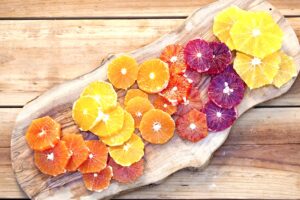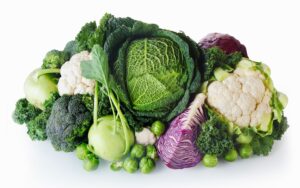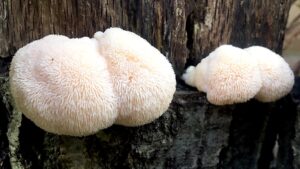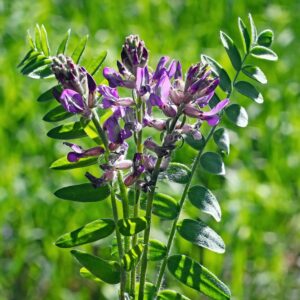
Sicilian blood orange salad
BY DEBRA KEEFER RAMAGE
Be a superperson!
You can be an actual superperson with these three weird tricks. 1. Eat superfoods! 2. Use superherbs! 3. Move your superbody! But, I hear you say, how do I know what is really a superfood when almost every food claims to be? And aren’t all herbs superherbs? And what if I don’t actually have a superbody? Never fear; all your questions will be answered, and it will be superclear what to do.
Superfoods
Yeah, it’s true, the whole superfood thing has kinda jumped the shark, leaving us none the wiser. But the concept that some foods are significantly more useful nutritionally than others, even if not all of these apply to all people, is still helpful in deciding what to eat.
UC Davis says in an article about superfoods: “The word superfood may look impressive and even stop you in your tracks when grocery shopping — but in reality, in most cases, it’s just marketing jargon. The term may have originated in the early 20th century around the promotion of bananas.”

Cruciferous vegetables
Using a journalist’s version of the “scientific method” (i.e., I know what real science is, and this is journalism) I read and compared nearly a dozen recent list articles about putative superfoods, and distilled out a common-sense top 10, mainly by eliminating weird things and things that only appeared in one list.
Cruciferous vegetables – broccoli, cauliflower, Brussels sprouts, napa cabbage, bok choy and kale (and also radishes, turnips, kohlrabi and watercress). Traditionally steamed, boiled, or eaten raw, many are also good roasted, or sliced or shaved and then stir-fried. Lately it has become a food fashion to make cauliflower into “rice” or pizza crust. They pair very well with the next super category.
Fermented foods – sauerkraut and its fancier cousin, kimchi; vinegars; kefir, yogurt, and cheese (if not pasteurized; can be made from either dairy milk or a substitute); kombucha and other fermented drinks; miso, tempeh, and real fermented soy sauce; pickled fruits and vegetables. Choose sourdough bread over commercially yeasted.

Lion’s mane mushrooms for brain health
Mushrooms – varieties that used to be rare in shops or restaurants are becoming common, and have amazing health benefits, such as lion’s mane for brain health, or reishi for stress resistance. Shiitake mushrooms are even available frozen. One strong opinion of mine that’s a bit controversial is to never eat mushrooms raw, as even “safe” ones can damage your liver over time.
Nuts and seeds and their butters – especially pistachios, almonds, walnuts, tahini and pepitas.
Fish – fatty fish like salmon and tuna, or ocean whitefish like halibut or cod, or freshwater fish like walleye or trout.
Tea – black, green, white, dark or herbal. See the superherb list for the best herbal ones.
Citrus fruit – especially blood oranges, lemons, pomelo.
Berries – especially strawberries and blueberries.
Wild rice, quinoa, buckwheat, chia – all “superseeds” that are treated as grain.
Dark chocolate, unsweetened chocolate, cacao nibs – but please, only if fair trade.

Passion flower supplement helps with sleep problems and anxiety.
Superherbs
Herbs can be part of your diet or can be taken as remedies for specific conditions. Don’t assume all herbs are safe, any more than you would with pharmaceuticals. If you’re not prepared to do a lot of research, find an advisor or an herbalist who has done it. That being said, my list includes only things that are safe for everyone, barring an allergy or a crazy overdose. Sources for herbs include pharmacies and food co-ops, specialized stores like Present Moment, naturopaths and chiropractors, or online shops like iHerb.com.
My top 10 list (compiled in a similar way to the first list):
Astragalus – this amazing herb is known for boosting immunity but has recently been found to actually lengthen and repair the telomeres of DNA, which in turn would reverse aging.
Nettles (plus quercetin) – can be taken in capsules or drunk as tea.

Astragalus, an amazing immunity booster
Cornish Yarg is a rare gourmet white cheese from the south of England encased in wildcrafted nettles!
Garlic and other alliums – good for immunity, a natural antibiotic, and clears the sinuses.
Tulsi (holy basil) – calming and even mildly sleep-inducing.
Hibiscus – helps regulate blood sugar, makes delicious hot tea, or if sweetened and iced, it is the Mexican agua de Jamaica.
Turmeric, ginger, galangal – all related spicy roots with powerful health benefits; turmeric is used to make “golden milk,” a honey-sweetened bedtime drink from ayurvedic medicine.
Elecampane – the lung clearing herb. I use a strong tonic called Deep Lung from Wishgarden Herbs.
Psyllium – not strictly an herb, it is Plantago ovata seed husks that provide excellent soluble fiber, with digestive and heart health benefits.
Valerian – a natural muscle relaxant, the pharmaceutical Valium was based on it.

Buckwheat crop, a ‘superseed’
Passion flower – a common sleep aid, it also lowers blood pressure and helps with anxiety and even ADHD.
Exercise for your superbody
Yes, you do too have a superbody. Use it vigorously but gently in the following pursuits, which you can learn in person in low-cost classes or online via videos and apps. Practice mindful meditation, get out in nature as much as you can, get enough sleep (whatever that is for you), and do these activities to enrich your life.
Yoga. There are many varieties. As a youth, I did kundalini yoga (what a rush!) and a spotty practice of hatha yoga (I can hardly believe it, but at one time I could stand on my head!). As a middle-aged striver, I did weekly Dru Yoga in England, in a Spiritualist church building that was 150 years old. I did hot yoga once but it’s not for me. (A lot of people love it, though.) Now I’m old and creaky, but I can still do chair yoga, and a very controlled and perfect standing Warrior Pose.

Aikido is for everybody.
Pilates. This is the perfect regimen for anyone with a physical disability since it was actually invented to treat dancers’ injuries. Mat Pilates requires the ability to get down on the floor, but like yoga, seated and standing forms have been added. Reformer Pilates uses a wooden exercise machine and can support almost any body with ease.
Gentle martial arts. Tai Chi is the most well-known, but Qi Gong is gaining on it. If you are already more fit, but just don’t fancy kicking and punching, try the Japanese “peaceful” art of aikido.






















